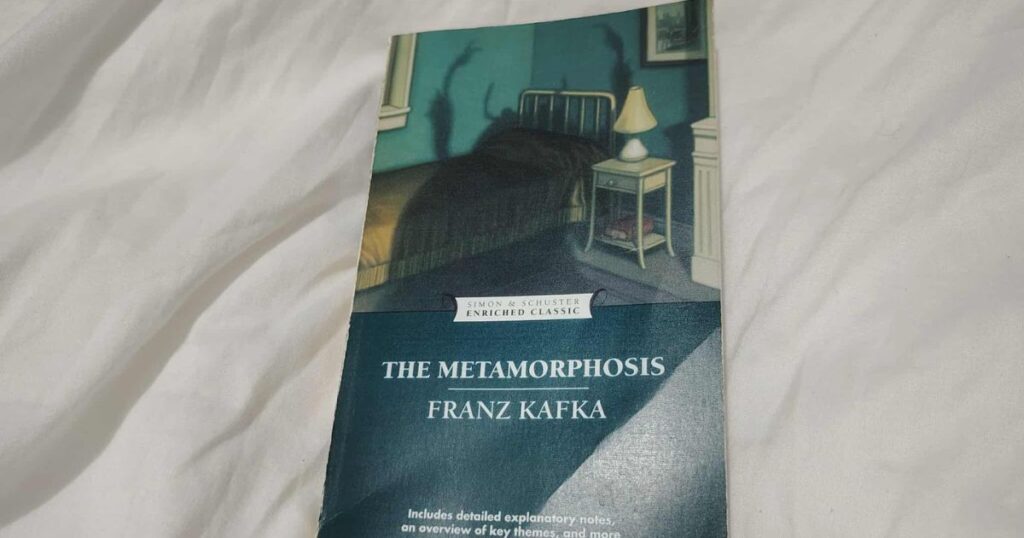Franz Kafka’s The Metamorphosis is more than a surreal tale of transformation — it’s a sharp, unsettling look into the heart of family life. What happens when the person who holds the household together can no longer fulfill that role? What does it reveal about the love and support we think are unconditional? This novella asks those questions through the tragic story of Gregor Samsa, inviting us to reflect on how families treat those who become “inconvenient.”
Disclaimer: While The Metamorphosis explores several rich themes such as identity, isolation, and existential despair, this blog post focuses specifically on the family dynamics portrayed in the story. The lens used here emphasizes Gregor’s role as a breadwinner and how his transformation affects his place within the household
🧩 Elements of The Metamorphosis
The Metamorphosis by Franz Kafka is a classic example of a novella, using its brief format to deliver a powerful exploration of alienation and family roles.
1. Focused Plot – One Central Conflict
Gregor’s sudden transformation into an insect creates a single, focused conflict: how his new form disrupts his role in the family and society.
2. Limited Characters – Often Centered on One Protagonist
The story revolves around Gregor Samsa, with only a few other key characters: his parents, sister Grete, and a few minor figures like the office manager and tenants.
3. Compact Length – Around 20,000 to 40,000 Words
The Metamorphosis fits the novella length, allowing for deep exploration without unnecessary subplots.
4. Thematic Depth – Identity, Isolation, Morality
Kafka dives into complex themes: alienation, the value of a person, conditional love, and existential despair — all within a short narrative.
5. Single or Few Settings – To Maintain Narrative Focus
The entire story takes place almost exclusively in the Samsa family apartment, especially Gregor’s bedroom — emphasizing his physical and emotional isolation.
6. Character Transformation – Emotional or Psychological Shifts
Gregor undergoes not just a physical metamorphosis, but a psychological one too. He shifts from a dutiful son to a creature abandoned and stripped of humanity — while his family undergoes their own transformation in how they perceive and treat him.
📖 Summary of The Metamorphosis
In The Metamorphosis, Gregor Samsa, a traveling salesman and the sole provider for his family, wakes up one morning to find himself transformed into a giant insect. Initially, his family is shocked and somewhat sympathetic, but their concern quickly fades. As Gregor becomes unable to work, he loses his position as the breadwinner. His physical transformation becomes a symbol of uselessness in their eyes.
Over time, his family isolates him, hides him away, and grows resentful of his presence. His sister, once his closest ally, becomes indifferent. His father, who had been financially dependent on Gregor, returns to work and becomes more assertive. Eventually, Gregor dies alone and unwanted — and the family feels relief.
💬 Personal Commentary
Kafka’s novella paints a brutal but honest picture of conditional love within families. At its heart lies a haunting question: what happens to family bonds when someone can no longer contribute financially?
Gregor’s transformation is physical, but the real “metamorphosis” is how his family’s love and loyalty shift. When he can no longer provide, he is no longer seen as a son or sibling — just a burden. This reveals a disturbing truth: family dynamics often revolve around usefulness, not unconditional care.
As a breadwinner myself, this story hits close to home. It’s painful — and strangely validating — to see the struggles of so many breadwinners reflected in a literary work written over a century ago. The Metamorphosis was published around the time of World War I, yet the emotional realities it portrays haven’t changed much.
Here in the Philippines, there’s a deeply rooted belief that children must give back to their parents — especially the eldest. Often, the eldest becomes the breadwinner, not just for the parents, but for the entire family. And while I love my siblings and genuinely want to help, the harsh truth is that some parents pass their responsibilities onto their children. Worse, some treat their children like milking cows — valued only while they produce.
It’s heartbreaking that this mindset continues to be passed down through generations. But thankfully, change is slowly happening. Some people from the newer generations are becoming more mindful — delaying marriage or choosing not to have children unless they’re financially and emotionally ready. Others, like me, find joy in being fur-parents, choosing not to pass down trauma we haven’t fully healed from, for now.
FAQs About The Metamorphosis and Family Dynamics
1. What does The Metamorphosis reveal about family relationships?
It shows that family love can be conditional. When Gregor is no longer able to support his family financially, he’s seen as a burden rather than someone deserving of care — revealing how deeply tied love can be to utility.
2. Why is Gregor’s transformation significant in the story?
While Gregor physically turns into an insect, the deeper transformation is emotional and social — he loses his role, his identity, and eventually, the love of his family.
3. How does the novella reflect real-life expectations of breadwinners?
Much like in real life, Gregor is celebrated while he provides, but once he can’t, he is discarded. This mirrors the pressure many breadwinners face, especially in cultures where financial support equals worth.
4. Is The Metamorphosis still relevant today?
Absolutely. Despite being written over a century ago, the story’s themes — conditional love, identity loss, and the burden of family expectations — still resonate in today’s world, especially in cultures with strong familial obligations.
5. How does this relate to Filipino family culture?
In many Filipino households, the eldest child is expected to become the family’s breadwinner. This can create emotional pressure and financial strain, much like Gregor’s experience. The novella prompts a reflection on whether this dynamic is truly fair or sustainable.



